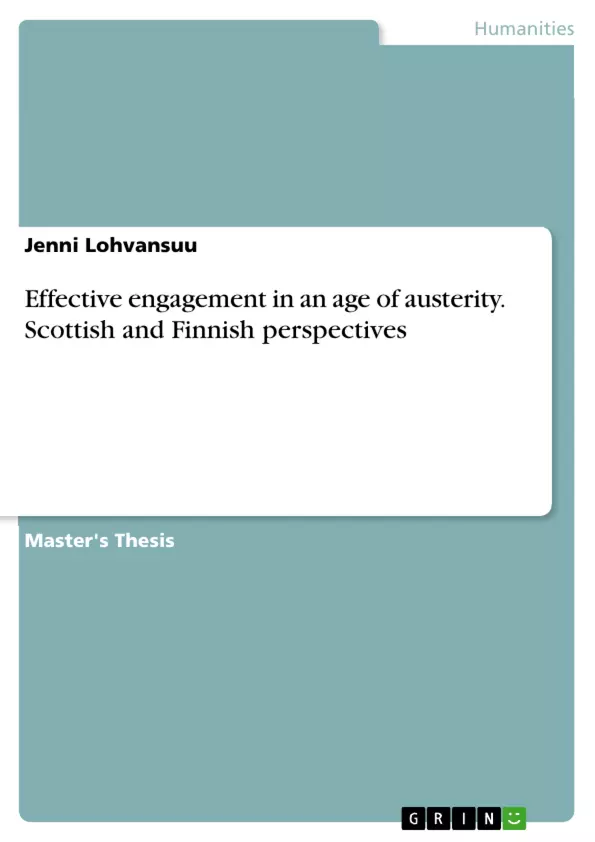This dissertation examines the extent to which Scottish and Finnish child protection practitioners perceive austerity measures to affect their ability to engage effectively service users. The data was gathered from practitioners in Scotland (n=4) and in Finland (n=4) through semi-structured interviews. A cross-national comparative thematic analysis was used to identify barriers to effective engagement and to explore the relationship between these barriers and austerity. Both Scottish and Finnish practitioners viewed limited resources and service users’ negative preconceptions as being the most significant factors that undermine effective engagement. Other factors regarded as challenges related to proceduralism, time restrictions, the power imbalance between practitioners and service users, and practitioners’ ineffective use of their core skills.
Overall, participants viewed the relationship between barriers to engagement and spending cuts as intertwined with other socio-political developments and public perceptions. Scarce resources, high workloads, and increased financial scrutiny in particular were attributed to austerity, although more often by Scottish than Finnish practitioners. However, most asserted that their abilities to engage with families remain unaffected by austerity, which highlights their professional resilience. However, Scottish and Finnish practitioners shared a concern that their ability to engage effectively with families may be undermined in the future should austerity persist.
Inhaltsverzeichnis (Table of Contents)
- Chapter 1 Introduction and overview
- 1.1 Aims and objectives
- Special considerations in a cross-national study
- 1.2 Scottish and Finnish child welfare – comparable contexts?
- Chapter 2 Child protection in an age of austerity
- 2.1 Austerity in Scotland and Finland
- 2.2 Child protection: Scottish and Finnish perspectives
- Shared emphasis of effective engagement
- 2.3 Summary and conclusion
- Chapter 3 Methodology and research design
- 3.1 Explorative and comparative methodology
- 3.2 Research design
- Data collection: an adaptive qualitative approach
- Thematic cross-national data analysis
- Working around bias: reflection and reflexivity
- 3.3 Summary and conclusion
- Chapter 4 Challenges to effective engagement
- 4.1 Challenges from practitioners' perspectives
- Limited resources
- Power imbalance
- Proceduralism and bureaucracy
- Time restrictions
- Service user-related factors
- Practitioner-related factors
- 4.2 Summary and conclusion
- Chapter 5 A temporal perspective to engagement opportunities
- 5.1 Remembering the past: more opportunities and choice
- 5.2 Here and now: resilient practitioners
- 5.3 Going forward: concerns about the future
- 5.4 Summary and conclusion
Zielsetzung und Themenschwerpunkte (Objectives and Key Themes)
This dissertation explores the impact of austerity measures on the ability of child protection practitioners in Scotland and Finland to effectively engage with service users. It investigates the challenges and barriers to effective engagement faced by practitioners in both countries, examining the relationship between these challenges and austerity measures.
- The impact of austerity on child protection practices in Scotland and Finland
- Barriers to effective engagement faced by child protection practitioners
- The relationship between austerity measures and challenges to effective engagement
- The resilience of practitioners in maintaining effective engagement despite austerity
- The potential future implications of austerity for effective engagement with families
Zusammenfassung der Kapitel (Chapter Summaries)
Chapter 1 introduces the dissertation's aims and objectives, highlighting the importance of examining the impact of austerity on child protection practices in a cross-national context. Chapter 2 delves into the effects of austerity in Scotland and Finland, exploring the perspectives of child protection practitioners in both countries and their shared emphasis on effective engagement. Chapter 3 outlines the methodology and research design, detailing the data collection and analysis methods used. Chapter 4 examines the challenges to effective engagement faced by practitioners, including limited resources, power imbalances, proceduralism, time restrictions, and service user-related factors. Chapter 5 provides a temporal perspective on engagement opportunities, considering the past, present, and future implications of austerity measures.
Schlüsselwörter (Keywords)
This dissertation focuses on the intersection of austerity, child protection, effective engagement, and cross-national comparisons, specifically examining the experiences of practitioners in Scotland and Finland. Key themes include the impact of limited resources, power imbalances, proceduralism, and time restrictions on effective engagement. The research highlights the resilience of practitioners in navigating these challenges and the potential future implications of austerity for child protection practices.
- Citar trabajo
- Jenni Lohvansuu (Autor), 2017, Effective engagement in an age of austerity. Scottish and Finnish perspectives, Múnich, GRIN Verlag, https://www.grin.com/document/369939



